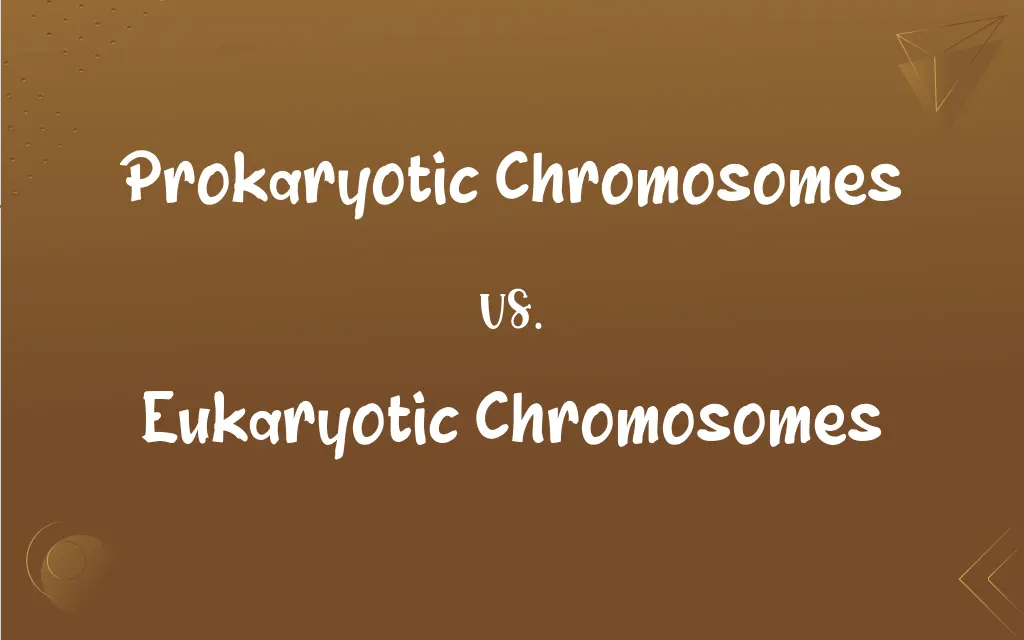Prokaryotic Chromosomes vs. Eukaryotic Chromosomes: What's the Difference?
Edited by Aimie Carlson || By Harlon Moss || Updated on October 28, 2023
Prokaryotic chromosomes are singular, circular DNA molecules in bacteria, while eukaryotic chromosomes are multiple, linear DNA molecules in cell nuclei.

Key Differences
Within the intricate realm of cellular biology, the distinctions between prokaryotic chromosomes and eukaryotic chromosomes are paramount. Prokaryotic chromosomes typically manifest as a singular, circular DNA molecule, predominantly observed in bacteria. In contrast, eukaryotic chromosomes exist as multiple, linear DNA molecules housed within the nucleus of the cell.
When assessing the organizational complexity, prokaryotic chromosomes exhibit a more straightforward structure without histones. However, eukaryotic chromosomes intricately wind around proteins called histones, facilitating compaction and proper chromosome segregation during cell division. This interaction with histones also allows eukaryotic genes to be regulated more diversely.
Diving into replication, prokaryotic chromosomes undergo a process that is relatively rapid and initiates from a specific point on the circular DNA. On the other side, eukaryotic chromosomes replicate in a more controlled manner, involving several checkpoints, ensuring accurate DNA replication and error correction.
Centrally, the cellular environments housing these chromosomes also differ. Prokaryotic chromosomes reside directly in the cytoplasm due to the absence of a defined nucleus in prokaryotic cells. Contrarily, eukaryotic chromosomes are safeguarded within a membrane-bound nucleus, protecting the genetic material and segregating it from the cytoplasm.
To encapsulate, prokaryotic chromosomes represent the simplistic, circular DNA structures predominantly seen in bacteria, while eukaryotic chromosomes denote the more complex, linear DNA structures ensconced within the cell's nucleus.
ADVERTISEMENT
Comparison Chart
Shape
Circular
Linear
Number
Typically one
Multiple
Location
Cytoplasm
Nucleus
Association with Histones
Absent
Present
Replication Initiation
From a specific point on the circular DNA
At various specific origins of replication on the linear DNA
ADVERTISEMENT
Prokaryotic Chromosomes and Eukaryotic Chromosomes Definitions
Prokaryotic Chromosomes
Prokaryotic ChromosomesSingular circular DNA in bacteria.
The bacterial cell contained a simple prokaryotic chromosome within its cytoplasm.
Eukaryotic Chromosomes
DNA strands vital for eukaryotic cell functions.
Eukaryotic chromosomes undergo complex replication and repair mechanisms to maintain genetic fidelity.
Prokaryotic Chromosomes
Prokaryotic ChromosomesCompact DNA structure in the cytoplasm.
Despite its simplicity, the prokaryotic chromosome carries all the essential genes for the bacterium's survival.
Eukaryotic Chromosomes
Multiple linear DNA molecules in cell nuclei.
Human cells, like many eukaryotes, house eukaryotic chromosomes within a defined nucleus.
Prokaryotic Chromosomes
Prokaryotic ChromosomesDNA structures without histone association.
Prokaryotic chromosomes lack the intricacies of histone wrapping seen in eukaryotic cells.
Eukaryotic Chromosomes
Chromosomes that segregate during mitosis and meiosis.
The proper segregation of eukaryotic chromosomes is crucial for cell division and genetic inheritance.
Prokaryotic Chromosomes
Prokaryotic ChromosomesDNA responsible for basic bacterial functions.
Mutations in the prokaryotic chromosome can influence the bacteria's antibiotic resistance.
Eukaryotic Chromosomes
DNA wound around histone proteins.
The interaction with histones allows eukaryotic chromosomes to compact into the cell nucleus efficiently.
Prokaryotic Chromosomes
Prokaryotic ChromosomesGenetic material in prokaryotic organisms.
Through electron microscopy, we visualized the prokaryotic chromosome in the sample.
Eukaryotic Chromosomes
Genetic material in eukaryotic organisms.
Errors during the replication of eukaryotic chromosomes can lead to genetic disorders.
FAQs
How do eukaryotic chromosomes differ from prokaryotic chromosomes?
Eukaryotic chromosomes are multiple, linear DNA molecules located in the cell's nucleus.
Do prokaryotic chromosomes have histones?
No, prokaryotic chromosomes typically lack histones.
What role do histones play with eukaryotic chromosomes?
Histones allow eukaryotic DNA to wind around them, facilitating chromosome compaction and gene regulation.
Do prokaryotic chromosomes undergo mitosis?
No, prokaryotes replicate their chromosome and divide through binary fission.
How do eukaryotic chromosomes compact inside the nucleus?
Eukaryotic chromosomes wind around histone proteins, allowing them to compact efficiently.
Can prokaryotic cells have more than one prokaryotic chromosome?
While most prokaryotes have a single chromosome, some can have plasmids, which are small, circular DNA fragments.
How many eukaryotic chromosomes do humans have?
Humans have 46 eukaryotic chromosomes, organized into 23 pairs.
Do eukaryotic chromosomes have centromeres?
Yes, eukaryotic chromosomes have centromeres, which are essential during cell division.
How do eukaryotic chromosomes segregate during cell division?
Eukaryotic chromosomes segregate through the processes of mitosis (somatic cells) and meiosis (germ cells).
Are eukaryotic chromosome numbers consistent across species?
No, different eukaryotic species have varying numbers of chromosomes.
Are eukaryotic chromosomes always linear?
Yes, eukaryotic chromosomes are linear and housed within the cell's nucleus.
Why are prokaryotic chromosomes circular?
The circular nature of prokaryotic chromosomes is inherent to their simplicity and the way they replicate.
How do prokaryotic and eukaryotic chromosomes respond to DNA damage?
Both have repair mechanisms, but eukaryotic chromosomes possess more intricate repair pathways due to their complexity.
What are prokaryotic chromosomes?
Prokaryotic chromosomes are singular, circular DNA molecules typically found in bacteria.
Where are prokaryotic chromosomes located in the cell?
Prokaryotic chromosomes are located directly in the cytoplasm.
How is the replication of eukaryotic chromosomes regulated?
Eukaryotic chromosome replication is controlled through multiple checkpoints ensuring accuracy.
How are prokaryotic chromosomes passed to offspring?
Prokaryotic chromosomes are replicated and then distributed to the daughter cells during binary fission.
Can changes in prokaryotic chromosomes lead to antibiotic resistance?
Yes, mutations in prokaryotic chromosomes can confer antibiotic resistance to bacteria.
Why don't prokaryotic chromosomes need a nucleus?
Prokaryotic chromosomes are simpler and reside directly in the cytoplasm without a need for a segregated nucleus.
Are all eukaryotic chromosomes of the same size?
No, eukaryotic chromosomes vary in size and gene content.
About Author
Written by
Harlon MossHarlon is a seasoned quality moderator and accomplished content writer for Difference Wiki. An alumnus of the prestigious University of California, he earned his degree in Computer Science. Leveraging his academic background, Harlon brings a meticulous and informed perspective to his work, ensuring content accuracy and excellence.
Edited by
Aimie CarlsonAimie Carlson, holding a master's degree in English literature, is a fervent English language enthusiast. She lends her writing talents to Difference Wiki, a prominent website that specializes in comparisons, offering readers insightful analyses that both captivate and inform.
































































